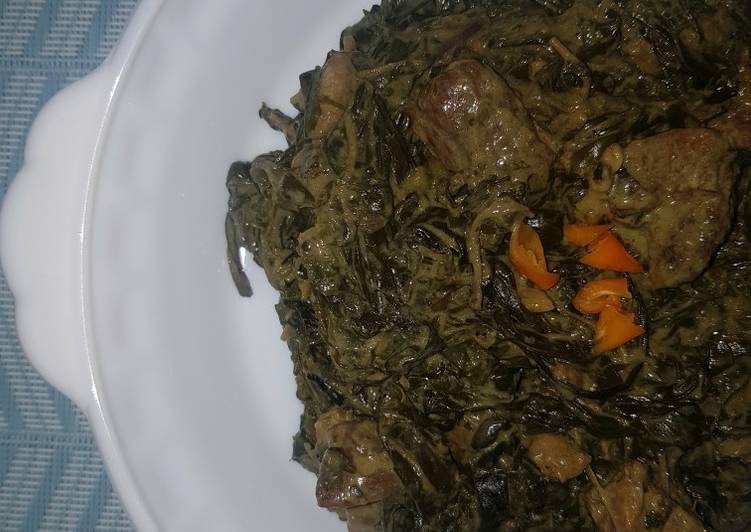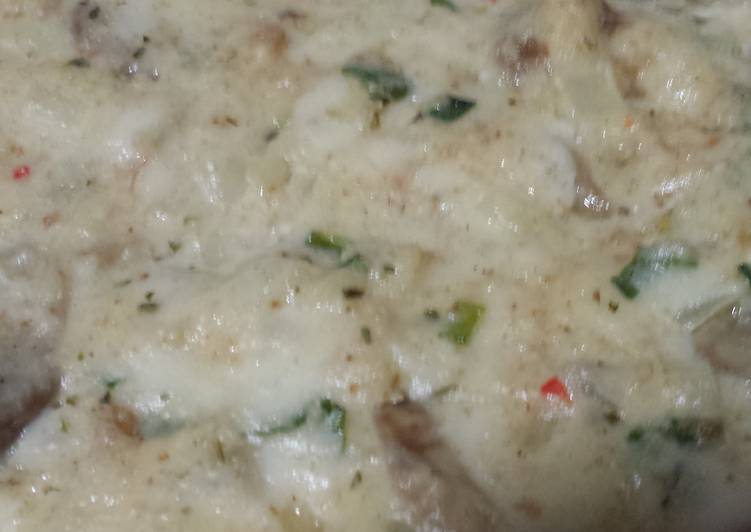
Hello everybody, it is Louise, welcome to my recipe page. Today, I’m gonna show you how to make a special dish, laing (taro leaves in coconut milk). One of my favorites food recipes. This time, I will make it a bit unique. This will be really delicious.
Laing (Taro Leaves in Coconut Milk) is one of the most popular of current trending meals on earth. It’s appreciated by millions daily. It’s easy, it’s fast, it tastes yummy. They are fine and they look fantastic. Laing (Taro Leaves in Coconut Milk) is something which I’ve loved my whole life.
Place coconut milk, water, onion, garlic and dried fish in a pot. Bring to boil over medium-low heat. Once it starts to boil, add the dried taro leaves. Ginataang Laing (Taro Leaves with Coconut Milk) Main course / By Cherry Mahaguay Laing is popular dish or originated from Bicol province of the the Philippines.
To get started with this particular recipe, we have to prepare a few ingredients. You can have laing (taro leaves in coconut milk) using 12 ingredients and 6 steps. Here is how you cook it.
The ingredients needed to make Laing (Taro Leaves in Coconut Milk):
- Get 2 ounces Dried Taro/Gabi Leaves
- Take 4 cups coconut milk
- Prepare 1 cup coconut cream
- Make ready 3 cloves garlic minced
- Make ready 1 onion diced
- Make ready 2 tablespoons bagoong/shrimp paste
- Take 1/2 ke pork cut thinly or cubes
- Get 1/2 cup hibe/dried shrimp
- Prepare 1 thumb-size ginger, peeled and minced
- Make ready 3 red chilis chopped (add more if you want)
- Get to taste Salt and pepper
- Take Cooking oil
Cooking different individual vegetables in coconut milk is a common for Filipinos but the one we called laing is the most exceptional and of course my specialty too. Laing is also known as taro leaves cooked in coconut milk and chilis. Laing is a spicy vegetable dish that is widely cooked in the Bicol Region in the Philippines. The "Gabi" or " Taro " grows well along Riverbanks and can be harvested by almost anyone who wants to prepare this Laing recipe.
Steps to make Laing (Taro Leaves in Coconut Milk):
- Heat pan and add oil. Saute garlic, onions and ginger until garlic is light golden brown and onions are translucent. Set aside.
- Using the same pan, season pork with a little bit of salt and pepper and cook for about 30 minutes or until brown and tender. Note: we will still add bagoong so do not add too much salt. Add back sauted garlic, onions and ginger, chilli, bagoong/shrimp paste and dried shrimp. Cook,for about 2-3 minutes.
- Add coconut milk bring to a boil on medium heat. Make sure to stir frequently to avoid it from burning.
- Add dried taro/gabi leaves and cook for 15-20 minutes without stirring to avoid getting itchy. Push down leaves to absorb coconut milk but do not stir until leaves have softened and turned a darker colour.
- Turn heat to low and cook for another 10-15 minutes, stirring every 5 minutes.
- Add coconut cream and let it simmer for an additional 10 minutes until dish is almost dry and most of the liquid has evaporated and begins to render fat. Add salt and pepper to taste. Remove from heat and serve with a side of steamed rice.
Laing is a spicy vegetable dish that is widely cooked in the Bicol Region in the Philippines. The "Gabi" or " Taro " grows well along Riverbanks and can be harvested by almost anyone who wants to prepare this Laing recipe. The best recipe of Laing (Taro leaves and stalks in coconut milk)! Lola's Authentic Laing (Taro Leaves in Coconut Milk) Laing is a Filipino dish composed of dried taro leaves and coconut milk. It was first introduced in the province of Bicol.
So that’s going to wrap this up with this exceptional food laing (taro leaves in coconut milk) recipe. Thank you very much for your time. I’m confident you can make this at home. There’s gonna be more interesting food in home recipes coming up. Don’t forget to bookmark this page in your browser, and share it to your family, friends and colleague. Thanks again for reading. Go on get cooking!

